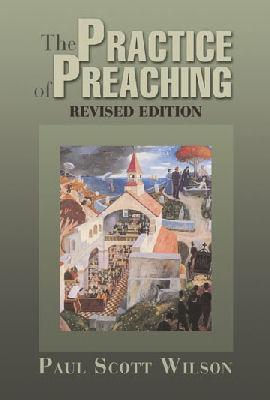
|
Posted October 8, 2007
Book: The Practice of Preaching: Revised Edition Author: Paul Scott Wilson Abingdon Press. Nashville, TN. 2007. Pp. 299 An Excerpt from the Preface:
Several assumptions were at work in the formation of this introduction. A textbook in preaching should: 1. Foster love of preaching and a love of language. 2. Draw on the history of preaching. 3. Fairly represent a variety of approaches. 4. Present preaching as a theological task. 5. Be practical. 6. Be challenging. 7. Present a coherent vision of future homiletical directions. 8. Contribute new insights. 9. Assist readers and instructors with examples, exercises, and guidelines along with theoretical understanding. 10. Meet the needs of students in helping them actually to prepare a sermon. An Excerpt from the Book: Mission and Hope Some preachers protest that grace cannot be the final note of the sermon. Sermons need to end with mission and lives of faithful service. As Samuel Proctor said, sermons need a So what? Or Therefore?, or the traditional language of the Bible, every sermon needs to answer for itself Micah’s question, what does the Lord require of us? All of this is true, yet preaching effects a transformation of the world by the Word, the same transformation from the old age to the new creation. Obedience is required, yet God gives everything to meet the demand. Various missions — feed the poor, visit the sick, care for shut-ins, take action for justice – in light of the gospel become ministries in which Christ promises to be found empowering faithful disciples. His promise to provide what is needed is what matters. This is Calvin’s third use of the law as an excitement to obedience, which is really grace, for as Paul said, “It is God who is at work in you, enabling you both to will and to work for his good pleasure.” Mission itself is transformed from an onerous, even impossible, task to something that has no power to defeat. Thus, by the end of the sermon, barriers to mission have been overcome by Jesus’ death on the cross. The gospel transforms the nature of mission. Exhortations to mission are no longer commandments; they are invitations to encounter the risen Christ in the power of a new era begun even in the preaching of the gospel. Presented in this light, people ideally reach for their ministry, want it, need it as the essential response to God. Response becomes a delight and privilege. The result of all of this is that even though there are tasks, people are sent away from church with hope and all of the resources grace provides. Table of Contents: Section 1: Monday: Getting Started 1. Biblical exegesis 2. Purposes of preaching 3. The gospel and the theme sentence Section II: Tuesday: Connecting the Bible and Today 4. Bridging from the text 5. Bridging to today Section III: Wednesday: Drawing on Experience 6. Exegesis of today’s world 7. The use of stories, images, and experiences Section IV: Thursday: What the Preacher Says 8. Sermon form 1: surface structures 9. Sermon form II: the deep structure Section V: Friday: Matters of Style and Substance 10. Speaking for the ear 11. Composing to persuade Section VI: Saturday: Gospel Matters 12. Steps toward the gospel 13. Preaching the gospel Appendix |
|
